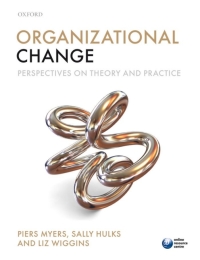In 2010, Toyota, the Japanese and international automobile manufacturer, had to recall an unprecedented number of vehicles
Question:
In 2010, Toyota, the Japanese and international automobile manufacturer, had to recall an unprecedented number of vehicles with brake and other faults, and attracted a great deal of negative publicity. Prior to this, however, Toyota had been lauded as a learning organization.
In fact, according to Liker (2004), of all of the companies of which he knew, Toyota was the best example of a learning organization. Lawler and Worley (2006) pick out Toyota as one of three examples of organizations ‘built to change’. By 2007, research firms had rated Toyota among the top car brands in terms of reliability, initial quality, and long-term durability for almost fifteen years, and Toyota was also the most profitable car manufacturer (Stewart and Raman, 2007).
Some Toyota practices are notably in keeping with the fi ve disciplines that Senge and his colleagues set out.
● Quality circles are used at the end of each week for production workers to analyse any problems in quality, productivity, or safety and to identify ‘countermeasures’ that they then test. These quality circles are said to have played a major role in the evolution of the famed
‘Toyota production system’, which we discuss in Chapter 9. There is, equally, an emphasis on the dissemination of know-how gained across the organization.
● There is an eagerness to experiment and to set (almost) impossible goals. For example, Toyota launched the Prius, the fi rst mass-produced hybrid car powered by petrol and electricity, in Japan in 1997 and worldwide in 2001. In a 2007 interview, Toyota’s then president, Katsuaki Watanabe, explained his vision:
I don’t know how many years it’s going to take us, but I want Toyota to come up with the dream car—a vehicle that can make the air cleaner than it is, a vehicle that cannot injure people, a vehicle that prevents accidents from happening, a vehicle that can make people healthier the longer they drive it, a vehicle that can excite, entertain, and evoke the emotions of its occupants, a vehicle that can drive around the world on just one tank of gas.
That’s what I dream about. . . . Our engineers are working right now to develop the technologies we need and to incorporate them into vehicles. If we accelerate our technology development, we can realize the dream car. (Stewart and Raman, 2007: 82).
● Teamwork is central at Toyota (Stewart and Raman, 2007): ‘each member of the team is accountable and has the authority and responsibility to fi nd a solution. The practice started on the factory fl oor and has spread throughout the corporation’ (Takeuchi et al., 2008: 102).
Without formally adopting dialogue as an approach to communication, open communication is emphasized, with face-to-face interactions a priority, freedom to express contrary opinions across the hierarchy, and refusal to listen to colleagues being seen as a ‘serious transgression’
(ibid: 103). However, in October 2009, 3.8 million vehicles were recalled in the US following fl oor mat problems, which had led in some cases to stuck accelerator pedals. More recalls over safety concerns followed, totalling 8.5 million worldwide by February 2010. The faults had, by then, been linked to hundreds of injuries and reports of a number of deaths.
On 24 February 2010, Akio Toyoda, president of Toyota Motor Corporation, appeared before the US Congressional Committee on Oversight and Government Reform, in a gruelling three-anda-
half-hour session. As part of his opening statement, he acknowledged that the company had got its priorities wrong:
Toyota has, for the past few years, been expanding its business rapidly. Quite frankly, I fear the pace at which we have grown may have been too quick. I would like to point out here that Toyota’s priority has traditionally been the following: fi rst, safety; second, quality; and third; volume. These priorities became confused, and we were not able to stop, think, and make improvements as much as we were able to before, and our basic stance to listen to customers’ voices to make better products has weakened somewhat. We pursued growth over the speed at which we were able to develop our people and our organization, and we should sincerely be mindful of that. I regret that this has resulted in the safety issues described in the recalls we face today, and I am deeply sorry for any accidents that Toyota drivers have experienced.
In April 2010, the US authorities levied a record fi ne of over US$16 million on the company, amid claims that recalls over faulty pedals had been delayed, initially being reported within the company as ‘customer satisfaction’ issues rather than safety concerns. Toyota’s reputation for quality had suffered enormous damage.
Questions 1. In view of the 2010 safety problems with Toyota cars, and the way in which recalls were handled, which of the following conclusions seem more appropriate to you, and why?
● The organization never really was a ‘learning organization’.
● Toyota was once a learning organization, but became less so during the fi rst decade of this century.
● As a learning organization, Toyota is in the process of learning from its safety mistakes.
2. What changes might Toyota need to make to learn more effectively and rapidly from customer safety concerns?
3. From the case, and other information that you can fi nd out about Toyota, can you identify a
‘dynamic capability’ of the company?
Step by Step Answer:

Organizational Change Perspectives On Theory And Practice
ISBN: 9780199573783,9780191512902
1st Edition
Authors: Piers Myers; Sally Hulks; Liz Wiggins





